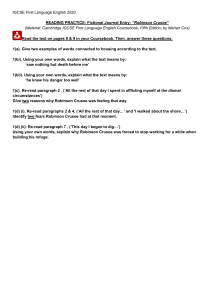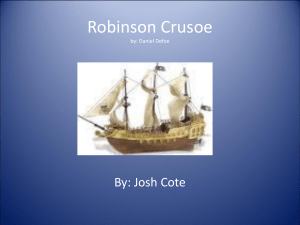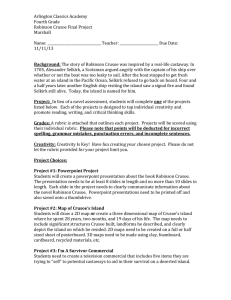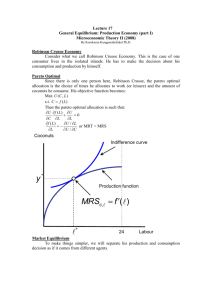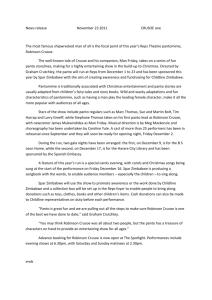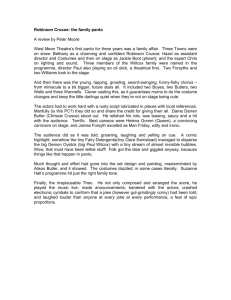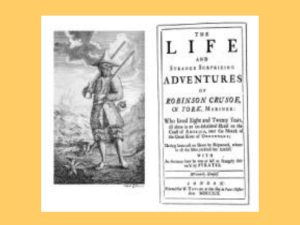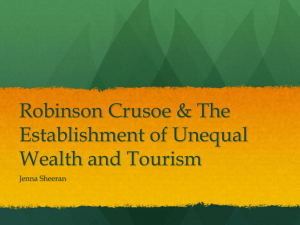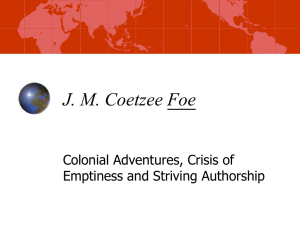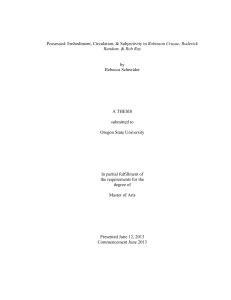Lesson - statecurriculum
advertisement
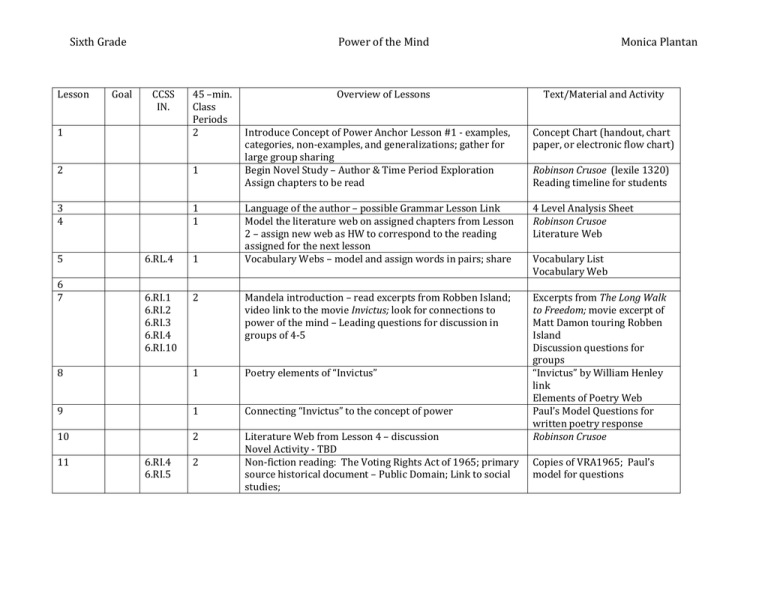
Sixth Grade Lesson 1 45 –min. Class Periods 2 2 1 3 4 1 1 5 Goal Power of the Mind CCSS IN. Overview of Lessons Concept Chart (handout, chart paper, or electronic flow chart) Language of the author – possible Grammar Lesson Link Model the literature web on assigned chapters from Lesson 2 – assign new web as HW to correspond to the reading assigned for the next lesson Vocabulary Webs – model and assign words in pairs; share 4 Level Analysis Sheet Robinson Crusoe Literature Web Excerpts from The Long Walk to Freedom; movie excerpt of Matt Damon touring Robben Island Discussion questions for groups “Invictus” by William Henley link Elements of Poetry Web Paul’s Model Questions for written poetry response Robinson Crusoe 1 6.RI.1 6.RI.2 6.RI.3 6.RI.4 6.RI.10 2 Mandela introduction – read excerpts from Robben Island; video link to the movie Invictus; look for connections to power of the mind – Leading questions for discussion in groups of 4-5 8 1 Poetry elements of “Invictus” 9 1 Connecting “Invictus” to the concept of power 10 2 Literature Web from Lesson 4 – discussion Novel Activity - TBD Non-fiction reading: The Voting Rights Act of 1965; primary source historical document – Public Domain; Link to social studies; 11 6.RI.4 6.RI.5 2 Text/Material and Activity Introduce Concept of Power Anchor Lesson #1 - examples, categories, non-examples, and generalizations; gather for large group sharing Begin Novel Study – Author & Time Period Exploration Assign chapters to be read 6.RL.4 6 7 Monica Plantan Robinson Crusoe (lexile 1320) Reading timeline for students Vocabulary List Vocabulary Web Copies of VRA1965; Paul’s model for questions Sixth Grade Power of the Mind Monica Plantan 12 2 Introduction to persuasion with pathos, logos, ethos; Show examples of hamburger model and work backwards – give students samples of persuasive writing and they fill in the graphic organizer Pathos, logos, ethos ppt./handout Samples of persuasive writing that include at least one counterargument – eg letters to editor; 6+1 trait models; etc. Hamburger model graphic organizer 13 1 WM research model adapted to the topic 14 2 15 1 16 17 2 1 Persuasion as the power to effect change; Introduction Brainstorm issues that students may want to research for their persuasion letters; for example - Cell phone to model the process; use research model adapted to the topic to begin research phase Persuasion as the power to effect change; students will use hamburger model to write persuasive letters to parents asking for something their parents do not want them to do/have. Homework – parents give them reasons against their request to use in the counterargument paragraph – students write first drafts Peer feedback on persuasive letters – Finalize letters during class time and deliver to parents as homework; parent/guardian signature to be returned Literature Lesson – Robinson Crusoe TBD Guest Speaker – Docent from local art museum or center – Power in Art 18 1 Writing Prompt – How is Power portrayed in the piece of art you chose from this lessons selected pieces? To which of our generalizations does it best relate? Letter Home to explain the lesson; hamburger model graphic organizer; WM research model adapted to the topic Peer feedback form Robinson Crusoe Docent will bring several pieces of art or may use electronic media to share pieces New pieces of art selected by the teacher (Public Domain) Sixth Grade Power of the Mind 19 2 In-class reading of the poem; check for understanding Informal Assessment – Anchor Lesson #2 Concept of Power – How does Kipling’s idea of what makes a man compare to our generalizations about power? PBL Lesson – Social Action – Technology Advisory Panel; introduce problem; complete Need to Know chart; 20 2 21 2 Research Lesson; New Information introduced to the PBL situation 22 23 1 2 24 2 25 2 26 27 2 2 28 2 29 30 31 1 1 2 32 2 Share outcomes of Technology Advisory Panel “The Tell-Tale Heart” using shared inquiry approach; 2nd class period - discussion “Through the Tunnel”; highlight evidence of Jerry being brave; fearful; small group discussion followed by large group sharing Critical Thinking Lesson Plan – Compare Contrast the protagonists’ ability to use their minds to power through fear or succumb to it. Cite specific examples from each of the short stories read in previous classes. Novel Lesson - TBD Critical Thinking Lesson Plan #2 – Power in Advertising; color, font, size, etc. Work in Pairs – Create a public service announcement on a current topic of personal interest; eg. Wash hands to avoid the spread of germs CPS – Topic: Isolation (as it relates to Robinson Crusoe) INSERT APPROPRIATE PLAY FROM ANTHOLOGY - TBD RC Culminating Activity – plot sequencing by identifying key scenes in the novel (plot triangle); script writing; Script writing – finalize; practice session; costumes as HW Monica Plantan “If” by Rudyard Kipling Socratic Seminar format District’s Acceptable Use Policy Problem Statement Need to Know chart District’s Acceptable Use Policy New Information handout Presentation Rubric Presentation Rubric Copy of the Short Story (public domain) Short story (link to it online) Both of the above short stories available for reference; Compare Contrast graphic organizer Robinson Crusoe Ad Council Ads (provided) Compare/Contrast Handout Information on color, font, placement, and size in advertising. CPS Handout Robinson Crusoe Use play from previous lesson as reference for scripts Sixth Grade Power of the Mind 33 2 Filming and editing 34 2 Share performances or movies in large group Monica Plantan Digital cameras; computers or can be done live Projector and screen
